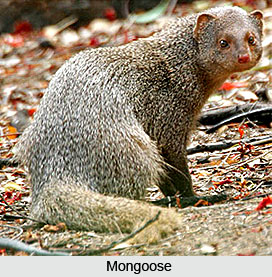 The Indian mongoose, scientifically known as Herpestes
javanicus, is a small carnivorous mammal belonging to the family Herpestidae.
It exhibits several distinct physical characteristics that aid in its
identification and survival in diverse environments. Adult Indian mongooses
typically measure between 36 to 45 centimeters in length, excluding their bushy
tails which add an additional 40 centimeters. They generally weigh between 0.6
to 1.5 kilograms.
The Indian mongoose, scientifically known as Herpestes
javanicus, is a small carnivorous mammal belonging to the family Herpestidae.
It exhibits several distinct physical characteristics that aid in its
identification and survival in diverse environments. Adult Indian mongooses
typically measure between 36 to 45 centimeters in length, excluding their bushy
tails which add an additional 40 centimeters. They generally weigh between 0.6
to 1.5 kilograms. Their bodies are slender and elongated, complemented by short legs, which contribute to their agility and speed. The fur of the Indian mongoose is coarse and varies in color from gray to brown, often with a grizzled appearance due to the presence of light and dark banded hairs. Their eyes are small and bright, reflecting a keen sense of sight, crucial for spotting prey. Mongooses possess sharp, curved claws that are well-adapted for digging and climbing.
Indian mongooses are highly adaptable animals that can thrive in a wide range of habitats. They are predominantly found in grasslands, open forests, and agricultural fields. Their preference for areas with dense undergrowth provides them with ample cover from predators and facilitates hunting. They are also known to inhabit human settlements, where they forage for food in garbage dumps and agricultural areas, thus sometimes being considered pests.
In their natural habitat, Indian mongooses create burrows or use natural shelters such as rock crevices and hollow logs. These shelters provide protection from predators and harsh weather conditions. Mongooses are diurnal creatures, meaning they are active during the day and rest at night. Their activity peaks during the early morning and late afternoon when they hunt for small mammals, birds, reptiles, and insects.
The Indian mongoose is widely distributed across the Indian subcontinent. In India, their presence is noted in various states, extending from the northern regions such as Jammu and Kashmir to the southern states like Kerala and Tamil Nadu. They are also prevalent in the central and western parts of the country, including Madhya Pradesh, Maharashtra, Gujarat, and Rajasthan.
Their adaptability to different environments has facilitated
their spread across various ecological zones. Indian mongooses are frequently
found in the agricultural landscapes of Punjab and Haryana, where they help
control rodent populations. In the forested areas of the Western Ghats and the
northeastern states, they play a significant role in the ecosystem as predators
of small vertebrates and insects.
In addition to their native range, Indian mongooses have been introduced to several other parts of the world, including the Caribbean, Hawaii, and Japan, primarily for pest control. However, in these introduced regions, they have become invasive species, threatening local wildlife and biodiversity.
The Indian mongoose is a remarkable example of an adaptable
and resilient mammal. Its distinct physical features, including a slender body,
sharp claws, and grizzled fur, contribute to its survival across varied
habitats. The species is widely distributed across India, thriving in diverse
environments ranging from grasslands and forests to human-modified landscapes.
Their role in controlling pest populations highlights their ecological
importance, although their introduction to non-native areas has underscored the
complexities of species management and conservation.